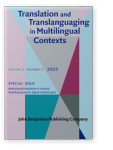Authorial (audio) description
Creativity in the transfer of CSRs in Squid Game
The unprecedented growth of audiovisual translation practices in the creative industries has boosted the role of
creativity which has taken centre stage and become the emblem of global cultural policies. The study addresses the role of
creativity in the digital space of Netflix as a means of cross-cultural mediation and communication, and as a multidimensional
tool in audio description (AD), in order to provide the end-users (the blind and visually impaired audiences) of digital audiovisual
products with participatory and engaging forms of access to the audiovisual ‘planet’. The aim is to investigate whether and how
creativity is used to transmit culture-specific references (CSRs) from a translation perspective within a highly discussed TV
series streamed on Netflix. To do so, the rendering of the most significant CSRs in the Korean Netflix series Squid
Game (SG) as transferred into the English and Italian ADs will be examined.
Article outline
- 1.Introduction
- 2.AD within intercultural mediation
- 3.AVT Creativity. The case of AD
- 4.Methodology: CSRs and tactics
- 5.Analysis of CSRs through translation tactics
- 5.1Location, food, and drinks
- 5.2Games and characters
- 6.Results and conclusions
- Acknowledgements
-
References
